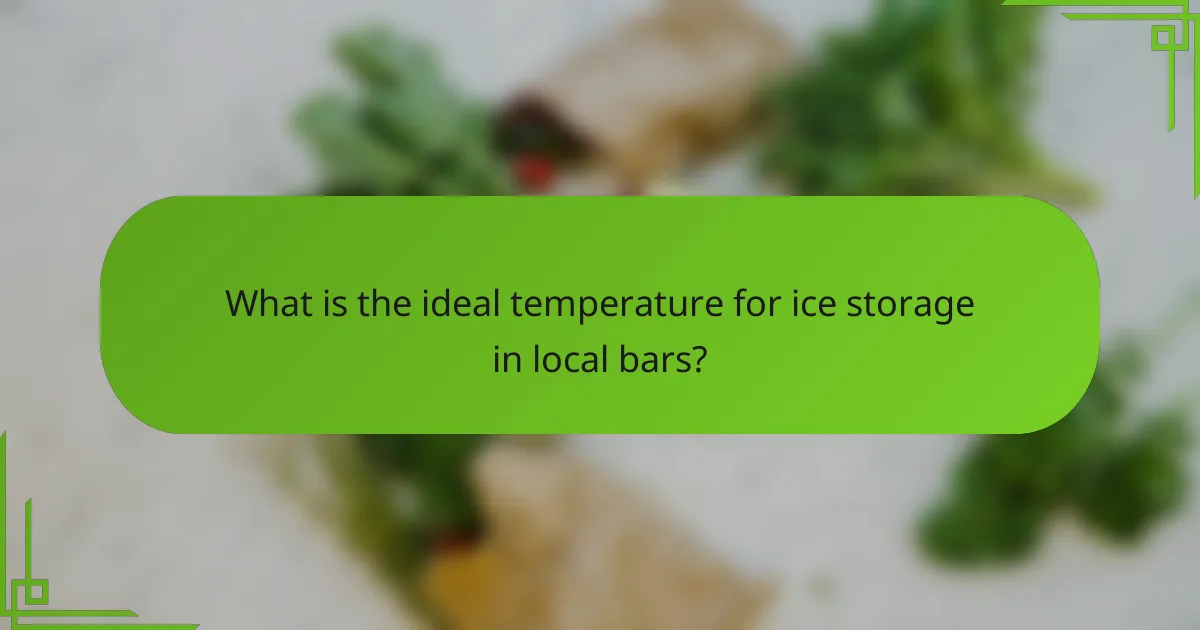Ice quality plays a crucial role in enhancing beverage experiences, particularly through its texture, temperature control, and dilution rate. The right ice texture can improve mouthfeel and presentation, while optimal storage temperatures between -5°C and -10°C help maintain its integrity and minimize unwanted dilution. Understanding the impact of dilution on flavor balance is essential for achieving the perfect drink.

How does ice texture affect beverage quality in Los Angeles?
Ice texture significantly influences beverage quality in Los Angeles by affecting mouthfeel, dilution rate, and presentation. The right texture can enhance the drinking experience, while the wrong type can detract from it.
Impact on mouthfeel
The texture of ice plays a crucial role in the mouthfeel of a beverage. For instance, larger, denser ice cubes provide a slow melt, resulting in a smoother, less watery drink. In contrast, crushed ice can create a more refreshing sensation but may lead to a quicker dilution.
In Los Angeles, where cocktails and iced beverages are popular, bartenders often choose ice with a texture that complements the drink’s character. For example, a whiskey on the rocks benefits from larger ice, while a blended cocktail might be better served with crushed ice for a slushy texture.
Influence on dilution rate
Ice texture directly impacts the dilution rate of beverages. Larger ice cubes melt slower than smaller ones, which means they dilute drinks at a slower pace, preserving flavor integrity for longer. This is particularly important for spirits served neat or on the rocks.
In contrast, crushed ice melts quickly, which can lead to a rapid dilution that may alter the intended taste of the drink. For optimal results, consider using larger ice for drinks that should remain strong and flavorful, while reserving crushed ice for those meant to be more refreshing and lighter.
Effect on presentation
The visual appeal of a beverage is enhanced by the type of ice used. Clear, large ice cubes can add an elegant touch to cocktails, making them more visually appealing in upscale venues throughout Los Angeles. On the other hand, crushed ice can give a casual, beachy vibe, suitable for tropical drinks.
When serving drinks, consider the context and desired atmosphere. For a sophisticated cocktail party, opt for larger, well-formed ice cubes. For a laid-back gathering, crushed ice can create a fun and inviting presentation that encourages casual sipping.

What is the ideal temperature for ice storage in local bars?
The ideal temperature for ice storage in local bars is typically between -5°C and -10°C (23°F to 14°F). This range helps maintain the ice’s integrity while minimizing melting and dilution in beverages.
Recommended storage temperature
For optimal ice quality, bars should aim to store ice at around -6°C (21°F). This temperature strikes a balance between keeping the ice solid and preventing it from becoming too brittle. Regularly monitoring the storage temperature can help ensure consistent ice performance.
Effects of temperature on ice quality
Temperature significantly impacts ice quality, affecting both texture and melting rate. Ice stored at higher temperatures tends to melt faster, leading to dilution in drinks, which can alter flavor profiles. Conversely, ice that is too cold may become hard and difficult to scoop, impacting service efficiency.
Maintaining the recommended storage temperature helps preserve the clarity and hardness of the ice. Clear ice, which is preferred for cocktails, forms better at lower temperatures, as it reduces air bubbles and impurities. Regular checks and adjustments to the storage environment can enhance overall ice quality and customer satisfaction.

How does dilution rate influence drink flavor?
Dilution rate significantly impacts the flavor of a drink by altering its strength and balance. A higher dilution can mellow strong flavors, while a lower dilution preserves intensity, making it crucial to find the right balance for optimal taste.
Optimal dilution for cocktails
The ideal dilution for cocktails typically ranges from 20% to 30%, depending on the drink type and personal preference. For example, stirred cocktails like a Martini benefit from less dilution, while shaken drinks like a Daiquiri may require more to achieve a smooth texture.
To achieve optimal dilution, consider the ice quality and the time spent mixing. Using larger ice cubes can slow the dilution process, allowing for a more controlled flavor profile.
Impact on taste profiles
Dilution affects taste profiles by softening harsh flavors and enhancing the overall balance. For instance, a drink with too much dilution may taste watery, while insufficient dilution can result in an overpowering alcohol presence.
Understanding the balance between dilution and flavor intensity is essential. Experimenting with different dilution rates can help identify the perfect mix for various cocktails, ensuring a well-rounded drinking experience.

What are the best practices for maintaining ice quality?
Maintaining ice quality involves controlling its texture, temperature, and dilution rate through effective practices. Key strategies include regular maintenance schedules and proper storage techniques to ensure the ice remains clear and solid for optimal use.
Regular maintenance schedules
Implementing regular maintenance schedules is crucial for preserving ice quality. This includes routine checks on ice-making equipment and ensuring that machines are cleaned and serviced according to manufacturer guidelines. Regular maintenance helps prevent contamination and ensures consistent ice production.
Establish a maintenance frequency based on usage patterns; for high-demand environments, weekly checks may be necessary, while less busy settings might require monthly inspections. Keeping a log of maintenance activities can help identify trends and areas needing attention.
Proper storage techniques
Proper storage techniques play a vital role in maintaining ice quality. Ice should be stored in a clean, insulated container that minimizes exposure to air and contaminants. This helps maintain its temperature and prevents melting or clumping.
Consider using a dedicated ice bin with a lid to protect against external elements. Regularly monitor the storage temperature, aiming for below freezing, and ensure that the ice is used within a reasonable timeframe to avoid degradation in quality.

How can local businesses optimize ice production?
Local businesses can optimize ice production by selecting the right equipment and implementing energy-efficient methods. These strategies not only enhance ice quality but also reduce operational costs and environmental impact.
Choosing the right ice maker
Selecting the appropriate ice maker is crucial for businesses that rely on ice. Factors to consider include the type of ice produced, production capacity, and the specific needs of the business, such as the volume of ice required during peak hours.
For example, a restaurant may benefit from a flake ice maker for its ability to cool beverages quickly, while a grocery store might prefer a cube ice maker for its longer-lasting properties. Assessing the daily ice demand can help in choosing a model that balances efficiency and output.
Energy-efficient production methods
Implementing energy-efficient production methods can significantly lower costs and reduce environmental impact. Techniques such as using programmable timers to operate ice machines during off-peak hours can lead to substantial energy savings.
Additionally, regular maintenance of ice machines ensures optimal performance and energy efficiency. Businesses should also consider investing in machines with high energy efficiency ratings, which can save up to 30% on energy costs compared to older models.

What are the common ice quality issues faced by restaurants?
Restaurants often encounter ice quality issues such as contamination, inconsistent texture, and dilution rates that can affect beverage presentation and taste. Addressing these problems is crucial for maintaining high standards in food and drink service.
Contamination risks
Contamination of ice can occur from various sources, including unclean ice machines, improper handling, and exposure to pollutants. Bacteria and viruses can thrive in ice if not properly managed, leading to potential health risks for customers.
To mitigate contamination, regularly clean and sanitize ice machines according to manufacturer guidelines. Use dedicated scoops for handling ice, and ensure staff are trained in proper hygiene practices to prevent cross-contamination.
Inconsistent texture problems
Inconsistent ice texture can affect the overall drinking experience, as different textures can alter how beverages are perceived. Ice that is too hard may not chill drinks effectively, while overly soft ice can dilute beverages too quickly.
To achieve consistent ice texture, monitor the freezing process and adjust the water quality and freezing time as needed. For cocktails, consider using clear, hard ice for a slow melt, while softer, crushed ice may be suitable for blended drinks or cocktails served in a casual setting.

How does ice quality impact customer satisfaction?
Ice quality significantly affects customer satisfaction by influencing the overall drinking experience. Factors such as texture, temperature control, and dilution rate play crucial roles in how customers perceive their beverages.
Customer perceptions of drink quality
Customers often associate high-quality ice with a better drink experience. Clear, well-formed ice cubes maintain the drink’s temperature longer and dilute it at a controlled rate, preserving the intended flavor profile. In contrast, poor-quality ice can lead to rapid dilution and undesirable changes in taste.
For instance, drinks served with cloudy or small ice cubes may be perceived as less appealing, impacting the overall impression of the establishment. Ensuring that ice is made from filtered water and stored properly can enhance customer perceptions significantly.
Influence on repeat business
Quality ice can directly influence repeat business as customers are likely to return to establishments that consistently deliver satisfying drink experiences. If patrons enjoy their beverages without unpleasant dilution or temperature issues, they are more inclined to recommend the venue to others.
Establishments should consider investing in ice machines that produce high-quality ice to ensure customer retention. Regularly assessing ice quality and making necessary adjustments can lead to improved customer loyalty and increased sales over time.

What emerging trends are shaping ice quality standards?
Emerging trends in ice quality standards focus on enhancing texture, optimizing temperature control, and managing dilution rates. These factors are crucial for ensuring that ice meets the demands of various applications, from food service to industrial uses.
Innovations in ice-making technology
Recent advancements in ice-making technology are significantly improving ice quality. Innovations such as modular ice machines and advanced refrigeration systems allow for better control over the freezing process, resulting in clearer and denser ice. These machines can produce ice in various shapes and sizes, catering to specific needs.
Additionally, some modern ice makers utilize water filtration systems that remove impurities, enhancing the clarity and taste of the ice. This is particularly important in the beverage industry, where the quality of ice can impact the overall customer experience.
When selecting ice-making technology, consider factors like production capacity, energy efficiency, and maintenance requirements. Investing in high-quality machines can lead to long-term savings and improved ice quality.


